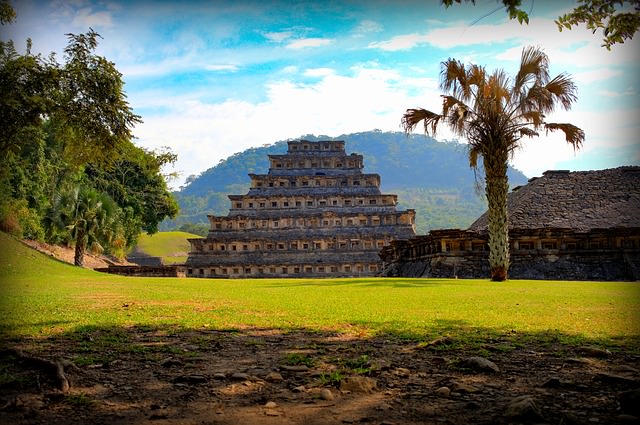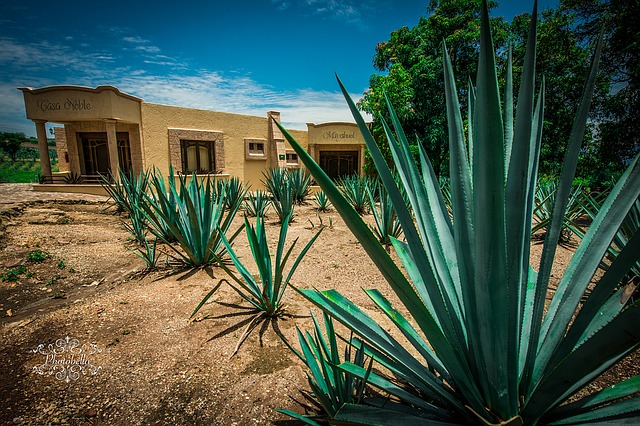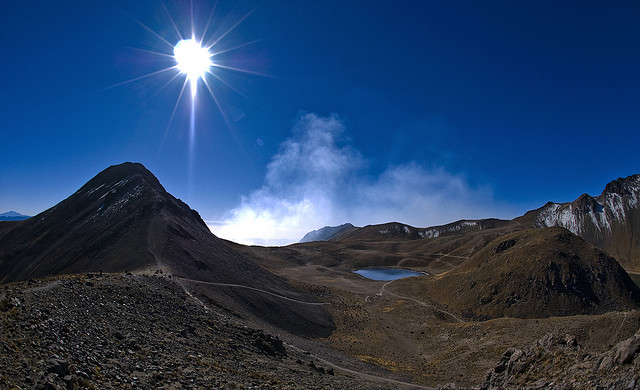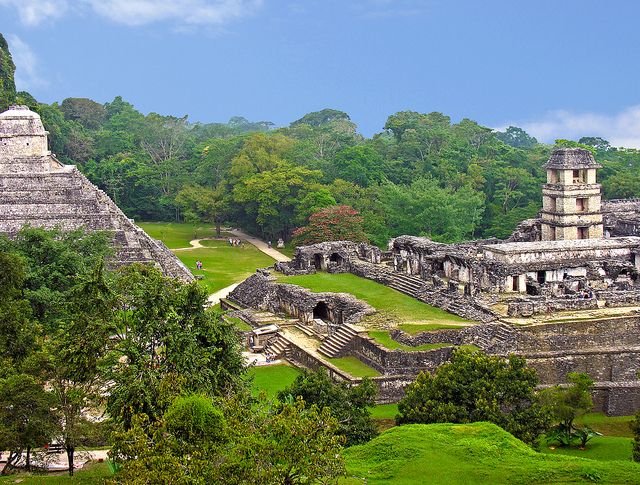Backpacking in Mexico
Mexico is the travel spot in Latin America as a whole. In 2012, Mexico ranked 13th as the world’s most exciting tourist destination. Who is surprised at the possibilities that travelers can experience there, no matter what kind? Water sports enthusiasts will get their money’s worth on the more than 10,000 km long coastline that stretches along the Gulf of Mexico, the Caribbean and the Pacific. Always warm weather, pleasant bathing temperatures – this is how you can endure a beach holiday in Mexico.
Travelers who want to see more of the country can explore the ancient indigenous cultures of the Aztecs and Mayans using countless archaeological excavation sites. In the lively and vibrant metropolises, a hospitable people awaits you, spoiling you with delicious Mexican food. But Mexico is not warm everywhere.
There are also snow-capped sierras, which you can only climb with winter clothes and mountaineering equipment. Or you can enter dense jungle areas where the climate is tropical and humid. Visit the top bathing resorts Acapulco, Cancun, Cozumel, Los Cabos and Mazatlan, where you can find accommodation here and there at reasonable prices.
However, Mexico is not the cheapest backpacker country. But if you try a little hard to find accommodation, you will find cheap accommodation and can travel cheaply through the country. Experience splendid colonial buildings for example in San Luis Potosi or dare a trip to Taxco in the mountain region, in which her real handicraft from silver and other precious metals gets at ridiculous prices. The most famous seaside resorts are on the Yucatan peninsula, but you have to decide for yourself if they are the best.
Whiter beaches like on the Isla Mujeres and the nearby Isla Holbox are hard to find worldwide. Near the sophisticated seaside resort of Playa del Carmen you’ll find the eco-parks Xcaret and Xel-Há. And from Cancun you can quickly reach the historic port of Tulum, close to which are a number of well-preserved Mayan buildings. Discover the Barrancas del Cobre adventure spot, which is a deep ravine that you can penetrate. Or visit the magnificent buildings in the cities of Veracruz and Puebla.
Tradition and culture in Mexico
Mexican culture is complex and diverse. This is because the country can look back on an ancient history in which various indigenous peoples dominated not only Mexico today, but a large part of Central and South America. All of them have left their mark over time. In addition, there are the various influences of European cultures that came into the country with different sources of immigration.
Today Mexican culture is essentially based on the cornerstones of close family ties, respect for others, hard work, solidarity and community. You should keep this in mind when dealing with Mexicans, so as not to step into a social-social fat-belly. In Mexico not only Spanish is spoken by far. In addition to the official national language, 67 other indigenous languages are recognised, including áhuatl, maya, mixteco and tzeltal.
Art is highly respected in Mexico. The first paintings in Mexico are about 7,500 years old and were discovered in caves in the state of Baja California. You can also see Mayan murals in Bonampak, Teotihuacan, Cacaxtla and Monte Albán. Everything still in its original state. In Mexico the biggest part of the population is Catholic. About 76 percent adhere to this faith. At the same time, this also means that most important holidays are of Catholic origin and are celebrated on the same days as in Europe.
The rest is divided into many different currents, including the belief in indigenous Mayan and Aztec deities. Mexican cuisine, one of the most varied in the world, is based on European, Cuban, indigenous and Asian influences, mixed with Middle Eastern cuisines. The traditional music of Mexico is the Son. There is also the mariachi, sinaloa, sonora and durango.
Backpacker Route in Mexico
There are enough backpacker routes in Mexico. There is something for everyone. You can experience adventures in mountaineering, go climbing in the bushes, admire the ancient Mayan temples and Aztec pyramids or hang out on some of the best beaches in the world or watch the underwater world. Of course, there is a lot more to do in Mexico. The Mescal Route for example or the nightlife in Mexico City, or Cancun.
Since Mexico is very big, there are also countless combinations of different routes. As always, when planning the backpacker route through Mexico, it is crucial how much time and budget you have available. A mixture of culture, adventure and activities in each city or region you would have to find yourself. Depending on how much time you have planned, you can also extend the route. Over time I will also make some more suggestions. But now a few suggestions for a few backpacker routes with and without suggestions for activities and trips:
Route 1: The classic (15-20 days)
- 2 days: Days of nightlife and culture in Mexico City.
- 2 days: Acapulco rock out
- 2 days: Enjoy Cancun beach life.
- 2 days mariachi music, tequiala and fun in Guadalajara.
- 1 day in Sea of Cortez swimming with dolphins.
- 1 day Monarch Schmettelingsfarm visit
- 1 day Chichen Itza -Maya visit buildings that are part of the UNESCO World Heritage.
- 1 day Coba Maya city experience at two lagoons.
- 1 day El Tajín – also part of the UNESCO World Heritage.
- 1 day swimming in Quezontes
Route 2: All over Mexico (32-42 days)
- 2 days: Days of nightlife and culture in Mexico City.
- 2 days: Acapulco rock out
- 2 days: Enjoy Cancun beach life.
- 2 days mariachi music, tequiala and fun in Guadalajara.
- 1 day in Sea of Cortez swimming with dolphins.
- 1 day Monarch Schmettelingsfarm visit
- 1 day Chichen Itza -Maya visit buildings that are part of the UNESCO World Heritage.
- 1 day Coba Maya city experience at two lagoons.
- 1 day El Tajín – also part of the UNESCO World Heritage.
- 1 day swimming in Quezontes
- Day 1: Whale watching in the Bahía Magdalena.
- Day 1: Visit swallow cave in San Luis Potosí.
- Day 1: Swim with whale sharks around Isla de Holbox in Quintana Roo.
- 2 days : Experience Oaxaca.
- 1 day:Visit Barrancas del Cobre – copper gorge.
- 1 Day:Pico de Orizaba – with 4800 m climb Mexico’s highest mountain.
- 1 Day:Experience wild nature on a white water rafting trip in Chiapa.
- 1 Day:In Rivera Maya hang out on the beach and discover nature parks.
- 1 Day:Hike through the Sierra Gorda.
- 1 Day:Experience the jungle in Quintana Roo.
- 1 day: Get to know Valle Bravo.
- 3 days: spend on a real hacienda.
- 2 days: San José del Cabo and the nightlife of Cabo San Lucas.
- 1 day: Jump off the cliffs in Acapulco.
- 3 days: Get to know the fishing villages of Boca de Tomatlán and Mismaloya.
Travel Times in Mexico
Four really different seasons like Germany are less known in Mexico. The country is too close to the equator for that. But it can get fresh through – especially in the highlands. You can travel to Mexico all year round. But it depends on what you want to do. As a rule, you can assume that the best travel times for Mexico are between November and March and the month of November. Imagine the weather situation as follows: If Europe has summer, then Mexico is dominated by the rainy season from May to October.
But that doesn’t mean that you can’t travel. It is still warm. It rains often, sometimes heavy, but never long at a time. Chiapas, Yucatán and the Pacific coast around Acapulco are best visited from November to March. The north of Mexico has average annual temperatures of over 23 degrees. It gets really “hot” in the region between June and September, then it is very hot and dry.
Backpacker Budget in Mexico
One thing ahead of the rest. Mexico is certainly not comparable with Central American countries such as Nicaragua or Honduras in terms of prices. Although there are certainly also cheap spots in Mexico. But the real tourist highlights cost just once. But Mexico is simply a too desired travel country. However, the country offers something for every purse. The entrance to different Maya ruins does not cost more than 2.5 euros for example. However, in an internationally renowned place like Tulum such a visit to one of the archaeological excavation sites can cost 10 euros. It is definitely more expensive in Cancun, Cozumel and Acapulco than in remote villages. You can get a hearty Mescal schnapps for about 2 Euro. A taxi ride in the city of Cancun, for example, costs around 1 – 2 euros.
The daily expenses amount to approximately 54 euro per person on average. These are distributed as follows:
- Accommodation between 10 and 29.94 Euro
- Food: around 11 euros
- Water: 1.50 Euro
- Local transport: 7.20 Euro
- Intercity Transport: 21.10 Euro
- Alcohol: 4.54 Euro
Bus and domestic fares in Mexico
You can also book domestic flights in Mexico. This is partly worth it because of the long distances. For a trip in an Intercity Bus you pay from 7 Euro for a 5 hour trip up to 30 Euro for a 9 hour overnight bus trip. However, in such a bus you also enjoy a certain comfort with AC and Movies. Taking local buses for long distances is cheap but painful. The prices for further routes in Mexico can be found on the pages of the bus companies. Some of them take you to the USA or other Central American countries.
Omnibus Mexicanos
- El Expresso
- Turimex Internacional
- TUFESA Bus Lines
- ADO/OCC
In Mexico, unlike other Latin American countries, there are also real cheap airlines. If you know the prices for a domestic flight, the best thing to do is look around on the websites of Aeromar, Aeromar, AeroMexico, Aeromexion, Magnicharters, Interjet, Volaris or VivaAerobus. Regional airlines are among others: Aereo Calafia, Aerotucan, Aero Pacifico and Mayair.
Flight times from Mexico City to
- Acapulco – 55 minutes
- Cancun – 90 minutes
- Chihuahua City – 75 minutes
- Guadalajara – 60 minutes
By boat you can enter from Guatemala or the USA.
There are also various train connections, but these are not always very regular or sporadic. From Los Mochis to Chihuahua a train runs several times a week for 86 Euro.
Backpacker Accommodations in Mexico
In a country like Mexico, which has probably the best tourist infrastructure in all Latin America, and which has to absorb a large number of visitors from the USA throughout the year at different times of the year such as the spring break, for example, there are all kinds of accommodations. Whether 5 star hotel or camping, whether a simple cottage at the lake or in the mountains or a cheap hostel on the beach, an eco hostel in the city, or the accommodation in a fashionable hacienda, every accommodation is available. The prices in the top hotel chains are in areas like North America and Europe.
Hotels in Mexico
Whatever kind of hotel you are looking for in Mexico, there is one. Whether 5 star, eco four stars, well-equipped 3 star hotels, simple 2 star hotels, or an inexpensive budget hotel. You will find any kind of hotel accommodation. If you have a lot of budget at your disposal, you can stay in the hotels of the hotel chains Palace Resorts, LeBlanc Spa Resort, Best Western, Holiday Inn, City Express, Fiesta Inn, Fairmont, Hilton, Ritz and a few more, which run through the whole country.
Hostels in Mexico
Staying in a hostel is usually affordable. There are more expensive countries in Latin America. Beds in a dorm of a hostel cost between 7 and 15 euros. Here are the average prices for a hostel bed in a dorm in different Mexican cities. You can also find the list in Hostelworld.
- Mexico City 11 Euro
- Cancun 13 Euro
- Playa del Carmen 15 Euro
- Tulum 11 Euro
- San Cristobal de las Casas 6-7 Euro
- Oaxaca 10 Euro
- Merida 7 Euro
- Isla Mujeres 12 Euro
- Puerto Escondido 8 Euro
- Guadalajara 9 Euro
Bed and Breakfast in Mexico
Bed and Breakfast accommodations are a good alternative. Especially if you are travelling in pairs, this can be worth it. Whether in Oaxaca, Cancún, Playa del Carmen, Mexico City, Islas Mujeres or Acapulco, bed and breakfast is everywhere. While in Mexico City a B and B costs around 30 Euros, in Cancun it is 32 Euros. Cheaper accommodation is at Playadel Carmen and in Tulum with about 23-25 Euros. In San Cristobal de las Casas there are even accommodations for 15 Euro. In Oaxaca you pay about 24-28 Euro. As said: everything only average.
Camping in Mexico
Camping is well known in Mexico. Some of the campsites are not far from the best spots. There are places for 4 Euro and others for 15 Euro. For example you can camp in the Parque Nacional El Chico, Hidalgo or you can camp at the dream beaches of San Agustinillo in Oaxaca. Campers who love nature should pitch their tents in the Reserva de la Biosfera de Calakmul, Campeche. We also recommend the campsite at the Cascadas de Agua Azul waterfalls in Chiapa. Make a campfire on the campsite at Laguna de Ochocachi in Chihuahua or camp on Isla de Venados.
Backpacker Trips, Tips & Highlights in Mexico
In Mexico there is a lot to see for backpackers. In Mexico City you can expect an attractive nightlife and a load of concentrated culture in the different museums of the city. But also fantastic beaches around Tulum, archaeological sites like Chichen Itza, wild nature parks like the Reserva de la Biosfera de Calakmul and much more await you in the Highlights section, where you will be introduced to trips that we would like to highlight in particular. Here it is necessary to introduce individual areas and tours bit by bit.
Please understand if this process takes a while, because we only report on tours that have already been made by other backpackers or are more or less well known and worth implementing…

Backpacking in Mexico – Maya Pyramide
Backpacker Highlights in Mexico
Mexico is a real cultural and adventure playground. In addition, the hottest beaches and an exciting nightlife in the various spots across the country await you. You can discover Mexico individually or in groups. No matter how you go about it, Mexico will remain unforgettable. For beach lovers and night owls, Acapulco on the Pacific is the first choice. You can surf and dive on the south coast of Acapulco on the beaches of Puerto Escondido and Puerto Angel and nude bathing on the Zipolite beach.
The fishing village of Zihuatanejo is still very quaint. If you’re looking for better surfing opportunities on wild lonely beaches, you’ll find them further north at Michoacán. Puerto Vallarta and Mazatlán are quite touristy, but at night the post goes out. Less busy is in the bay Bahía de Navidad, at the beaches of BITAS Kino or you can have a look at the black beaches of Cuyutlán.
In the extreme south of the Baja California peninsula, in the town of Cabo San Lucas, you can fish for the huge marlin on the high seas. The best beaches are in Yucatán on the Caribbean side. In the world-famous seaside resort of La Riviera Maya you’ll find dreamlike playas and old Mayan buildings. It’s worth a stop in Puerto Morelos in the bio-reserve Reserva de la Biósfera de SianKa’an. However, international tourism can also be found here. But the beaches are a dream.

Backpacking in Mexico – Cozumel
The archaeological sites of ancient Mexican cultures such as Tlaxcala, Tlax, ChichénItzá, Yuc, Temazcal in Morelos or Cuernavaca should definitely be on your visitor agenda in Mexico. Head to the magical Real de Catorce in San Luis Potosí. Due to its remote location in the Sierraspotosina, the place is often used as a background for filming. Cacti and desert everywhere.
Urgently into the first national park of Mexico, the Parque Nacional El Chico in Hidalgo. Adventurers should visit the copper gorge in Chihuahua, in the Sierra Tarahumara. You can also climb Citlaltépetl, which is part of the Sierra Madre Oriental and is over 5600 m high. The place Tequila or Tecuilan belongs because of its Tequilla production to the UNESCO world cultural heritage.
The Zacatlán de las Manzanas in Puebla, the one in the Sierra Norte de Puebla, also belongs to the many magic villages in Mexico. The apple trees bloom here, visible for miles. Tulum in QuintanaRoo is the spot for archaeology fans and beach lovers. Visit the Parque Nacional La Malintzi in Tlaxcala. Dense pine forests covered in thick fog extend at the foot of the volcano La Malinche. The adjacent Cerro de Xalapasco can also be climbed.
Backpacker insider tips in Mexico
If you’re looking for a wet inland adventure, head to the rapids and waterfalls of Cascadas de Agua Azul in Chiapas. Rafting and other wetting and strenuous activities are offered in a spectacular natural setting. You can circumnavigate the Isla de Venados, which consists of the small islands Isla de Pajaros and Isla de Lobos, by sea kayak.
Another recommended adventure sport is the IslasMarietas in Nayarit. The archipelago is located in the bay of Bahia de Banderas, where the fat right whales await you. More adventures await you at the Parque Nacional El Chico, in Hidalgo. You can choose from three campsites. Biking, trekking and so on, everything up to 3 900 m is possible. Pure nature. The semi-wild beach Playa San Agustinillo in Oaxaca is used by the sea turtles to lay their eggs.

Backpacking in Mexico – Mayan Ruins
Extreme athletes from all over the world come to the Parque Nacional Sierra de San Pedro Martir in the state of BajaCalifornia. And not for nothing. You can go up to the Cerro de la Encantada, but even better are the starry nights. Not for nothing there is a star observatory up there. You should definitely dive into a cenote once. You haven’t seen clearer water yet. Almost 1000 Cenotes are known in the Mexican state Quintana Roo alone.
The holes have on average a depth of about 15 meters, occasionally about 100 meters. The best are Parque de Cenotes Hidden Worlds in dos ojos. The Gran cenote in Tulum, the Cenote Cristal also in Tulum. Or you can do the complete Ruta de Cenotes in Cancún and Puerto Morelos. You can dive in the Cenotes Mojarras, Siete Bocas, Boca del Puma or Verde Lucero.
Food & Drinks in Mexico
Mexican cuisine is multifaceted and sometimes quite spicy. The reason for this is the many waves of immigration in which immigrants have brought their food culture with them into the country. In addition, there are the indigenous influences, the extinct peoples, the Mayas and Aztecs. Today, the country’s star chefs are again thinking about incorporating traditional dishes into the country’s cuisine. Mexico and Peru are by far the two Latin American countries that offer the best cuisine. Roughly speaking, Mexican cuisine can be divided into four regions, all of which have their own specialities.
In the north, beef and sheep meat are often served. Like their North American neighbours, the meat is grilled with preference. In the central region, corn and various spices dominate the dishes. Pozole, Menudo and Carnitas, among others, are well-known in the region. In the southeast chicken is eaten gladly and sometimes quite spicy. Here the Caribbean cuisine shows its influences. On the coasts you can try delicious seafood and fish with corn-based recipes in different variations.
Try Chicharrón – that’s roasted pork skin. Pretty crispy and oily. The dish comes with a hot chilli sauce very well. Also known are enchiladas. The tortillas filled with chicken or beef are served with different sauces. Some also with cheese. You won’t be able to get past the famous tacos on your Mexico trip.
The inexpensive corn tortillas, which are filled with all kinds of meat, but also innards, brains and the like, taste good and spare the budget. Tamales made from corn are also popular. They are available with meat filling or also in a sweet variant for snacks or breakfast. Tortas are not cakes, but a kind of Mexican sandwiches. It all depends on what the kitchen has to offer. Cheese lovers should try the delicious quesadillas. Grilled cheese is packed in corn tortillas.
Drinks in Mexico
Tap water is drinkable, but you better buy bottled water. You can easily add absinthe to your pear, because it’s legal. But it’s better to drink the local Tequila, which you don’t get so good and cheap anywhere else. A speciality is the national drink Pulque, which is extracted like the Mezcal from the Maguey cactus. Tepache is distilled from pineapple and tuba from the shoots of the coconut tree.
There is plenty of beer in Mexico. The local Corona tastes good. You can also find DosEquis, Modelo Especial (lager), NegraModelo (dark ale) or the popular light beer Modelo Light. Pacíficoiste in Pils of the better variety. Other beer brands are Tecate, Indio and Bohemia.

Mexico Backpacker
Of course you can get all kinds of soft drinks from the well-known brands. But try the Pozol made from corn or the Tejate made from corn and chocolate. Also delicious is Agua de Jamaica – a hibiscus tea or the many fruit shakes called Licuados de fruta in Mexico.
Backpacker Visa and Vaccinations in Mexico
The entry and visa requirements in Mexico are according to the Foreign Office as follows:
- Passport: Yes
- Provisional Passport: Yes
- Identity card: No
- Temporary ID Card: No
- Child Passport: Yes
Comments: Travel documents must still be valid for six months, but at least for the duration of the planned stay.
Visa
German citizens travelling to Mexico as tourists can enter without obtaining a visa beforehand. When entering Mexico, you will receive a tourist card (called “FMT”) by air or at other border crossing points. When crossing the border, the card is stamped and the validity period is entered.
The period of validity should be taken into account in order to avoid the need for later extensions. A later extension to up to six months can be applied for at the responsible authority in Mexico (Instituto Nacional de Migración). However, there is no entitlement to it. The remaining copy of the tourist card should be kept in a safe place, it must be presented when leaving Mexico.
Vaccinations and medical advice
The Federal Foreign Office recommends standard vaccinations according to the current vaccination calendar of the Robert Koch Institute. Malaria, dengue, leishmaniasis and leptospirosis are known in Mexico. Malaria-free areas include altitudes above 1,000m, larger cities and the Yucatan peninsula.


